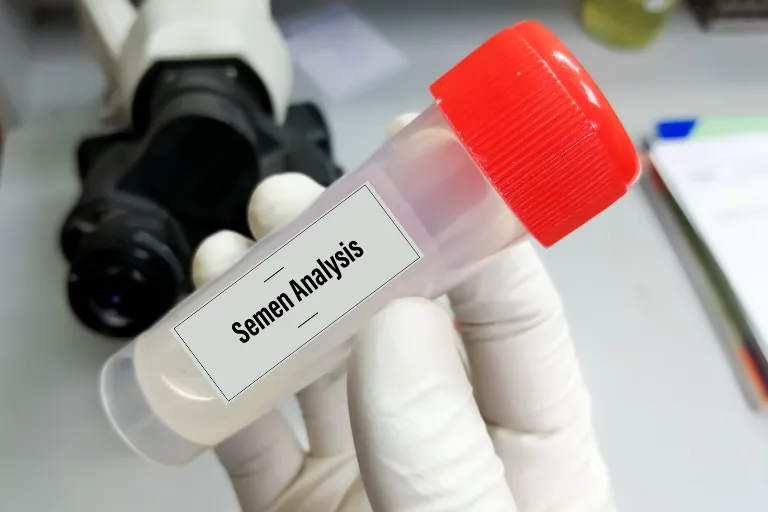Key Points
- Semen health plays a major role in male fertility and overall reproductive wellness.
- Key indicators include sperm count, motility, morphology, volume, pH, liquefaction time, and viscosity.
- Factors like smoking, heat exposure, stress, and diet can affect semen quality.
- A standard semen analysis, guided by WHO criteria, helps assess reproductive potential.
- Lifestyle changes and targeted supplements can support healthy semen parameters.
- Men should consider an evaluation if trying to conceive for over 12 months without success.
A Hidden Health Metric That’s Often Overlooked
When people think about reproductive health, they often focus on ovulation tracking, hormone cycles, or egg quality. But what about sperm?
Despite contributing to nearly half of all cases of fertility difficulty, semen health is rarely part of routine health conversations. Many men don’t know that sperm quality can be influenced by everyday factors like sleep, stress, heat exposure, and diet. Fewer still realize that semen parameters can serve as early warning signs for broader health concerns, including hormonal imbalances and urogenital inflammation.
Globally, infertility affects around 1 in 6 people, and male reproductive factors are involved in up to 50% of these cases, according to the World Health Organization (WHO).
Understanding semen health is no longer just a fertility issue—it’s a public health issue. And the first step is knowing what to look for.
Why Semen Health Matters
Semen is more than just a carrier for sperm—it’s a biologically sophisticated fluid designed to nourish and protect sperm on its journey to the egg. When semen parameters fall outside of optimal ranges, conception can become more difficult, even if no symptoms are otherwise present.
Healthy semen quality supports:
- Fertilization: Well-functioning sperm must swim effectively and survive long enough to reach the egg.
- Genetic integrity: Poor morphology or high DNA fragmentation may interfere with embryo development (Zini & Libman, 2006).
- Broader health awareness: Abnormal semen results may indicate systemic or endocrine issues.
Understanding the Core Indicators of Semen Health
A comprehensive semen analysis typically evaluates the following key parameters, based on WHO 2021 laboratory manual guidelines:
1. Sperm Count
- Normal: ≥15 million sperm/mL.
- A lower count (oligospermia) can signal issues such as varicocele, testicular injury, or hormonal disruption.
2. Motility
- Progressive motility refers to sperm that swim forward.
- Normal: ≥40% total motility, with ≥32% moving progressively.
Low motility (asthenozoospermia) may hinder the sperm’s ability to reach the egg (Agarwal et al., 2015).
3. Morphology
- Evaluated using Kruger’s strict criteria, where ≥4% of sperm should have a normal shape.
Abnormal morphology (teratozoospermia) has been associated with reduced fertilization potential (Ombelet et al., 1997).
4. Semen Volume
- Normal: 1.5–6 mL per ejaculation.
- Low volume may reflect duct obstruction or prostate/seminal vesicle dysfunction.
5. pH Level
- Optimal range: 7.2–8.0.
- Lower pH may suggest infection, while higher pH may indicate ejaculatory duct obstruction (WHO, 2021).
6. Liquefaction Time
- Normally occurs within 15–60 minutes post-ejaculation.
Delayed liquefaction can affect sperm movement and fertilization.
7. Viscosity and Color
- Healthy semen is usually milky-white and moderately fluid.
Yellow, brown, or excessively thick semen may suggest infection or blood presence.
The Physiology Behind Semen Production
Semen is a product of a coordinated system involving several reproductive organs:
- Spermatogenesis occurs in the testes, where sperm form over 64–72 days.
- Epididymis stores and matures sperm.
- Seminal vesicles and prostate gland contribute enzymes and fluid components essential for sperm viability.
Hormonal regulation—particularly by testosterone, FSH, and LH—is essential for this process. Disruptions in these hormones can lead to poor sperm output or quality (Zhou et al., 2021).
What Can Disrupt Semen Health?
Medical Conditions
- Varicocele, a common cause of testicular overheating.
- Urogenital infections, such as prostatitis or epididymitis.
- Hormonal imbalances or thyroid dysfunctions.
Environmental & Lifestyle Factors
- Chronic heat exposure (hot tubs, saunas, tight underwear).
- Smoking, alcohol, and recreational drug use.
- Obesity and sedentary lifestyle.
- Exposure to toxins (e.g., pesticides, phthalates) has been linked to decreased sperm quality (Martino-Andrade & Chahoud, 2010).
How Semen Health Is Tested
A semen analysis is the most common test used to evaluate male fertility. The sample is collected after 2–7 days of abstinence and analyzed for all the parameters listed above.
Additional or advanced diagnostic tools may include:
- DNA fragmentation index (DFI) for assessing genetic integrity.
- Oxidative stress testing, as oxidative damage can impair sperm function.
- FDA-authorized home kits like YoSperm or Trak can provide preliminary results, though they are not a substitute for laboratory testing (FDA, 2021).
Can You Improve Semen Health?
Yes—many aspects of semen quality can be influenced by daily habits.
A 2023 systematic review published in Andrology found that targeted lifestyle changes improved sperm parameters within 3 months (Calogero et al., 2023).
Recommended Approaches:
- Eat antioxidant-rich foods (berries, greens, seeds).
- Use supplements: zinc, CoQ10, L-carnitine, omega-3s.
- Exercise moderately, avoiding extreme endurance or heat exposure.
- Sleep 7–8 hours nightly.
- Manage stress with mindfulness, breathing exercises, or therapy.
- Avoid tobacco and limit alcohol.
When to Seek Medical Help
Couples under 35 should consider evaluation after 12 months of trying to conceive. For those over 35, the window shortens to 6 months. Additional signs to seek help include:
- Pain or swelling in the testicles
- History of infections or surgeries
- Erectile difficulties
- Past exposure to chemotherapy or radiation
Early intervention can lead to earlier solutions.
Final Thoughts: Know Your Numbers, Protect Your Potential
Semen health offers a powerful window into male reproductive and overall wellness. By understanding what defines healthy semen—and how to influence it—individuals can take control of their fertility journey and broader health goals. Testing is simple. Awareness is powerful. And improvement is often within reach.
The article does not in any way constitute as medical advice. Please seek consultation with a licensed medical professional before starting any treatment. This website may receive commissions from the links or products mentioned in this article.
Subscribe for Free for more insightful health articles tailored to your needs.
Sources
- WHO. Infertility Fact Sheet.
- WHO Laboratory Manual for the Examination and Processing of Human Semen, 6th Edition.
- Zini A, Libman J. “Sperm DNA damage: clinical significance in the era of assisted reproduction.” CMAJ. 2006;175(5):495–500. PubMed
- Agarwal A, Mulgund A, Hamada A, Chyatte MR. “A unique view on male infertility.” Reprod Biol Endocrinol. 2015;13:37. PubMed
- Ombelet W et al. “Semen quality and intrauterine insemination.” Fertil Steril. 1997;67(4):731–9. PubMed
- Zhou J et al. “Regulation of Spermatogenesis by FSH and Testosterone.” Front Endocrinol (Lausanne). 2021;12:607579. PMC
- Martino-Andrade AJ, Chahoud I. “Reproductive toxicity of phthalate esters.” Mol Nutr Food Res. 2010;54(1):148–57. PubMed
- FDA. Home-Use Semen Analysis Tests.
- Calogero AE et al. “Lifestyle changes and semen parameters: a systematic review.” Andrology. 2023;11(2):195–208. PubMed
Last Updated on August 1, 2025



